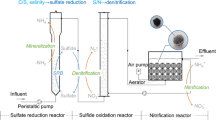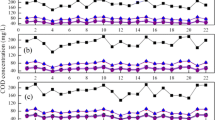Abstract
A new multi-point inflow pre-anoxic/oxic/anaerobic/anoxic/oxic (A1/O2/A3/A4/O5) sludge-membrane coupling process and pilot plant were developed and designed to solve the problem of nitrogen and phosphorus removal of low carbon and nitrogen (C/N) ratio domestic sewage in southern China. The removal effect and transformation rule of organic matter, nitrogen, and phosphorus in the system were studied by changing the distribution ratio of multi-point influent. The average C/N ratio of the influent was 2.09 and the influent distribution ratio was 1:1. When the temperature was 16–25 °C, the average concentrations of chemical oxygen demand (COD), ammonia nitrogen (NH4+- N), total nitrogen (TN), and total phosphorus (TP) in the effluent were 21.31 (±2.65), 0.60 (±0.24), 12.76 (±1.09), and 0.34 (±0.05) mg/L, respectively, and their average removals are 87.3 (±1.2)%, 98.7 (±0.4)%, 74.1 (±1.3)%, and 88.1 (±0.4)% respectively. When the low temperature was 12–15 °C, the average removals were 78.6 (±1.1)%, 90.5 (±1.3)%, 73.7 (±1.13)%, and 86.6 (±1.7)%, respectively. Compared with the traditional anaerobic/anoxic/aerobic (A2O) process under the same conditions, the TN removal was increased by 15.4%, and the TP removal was increased by 22.2%. This system has obvious advantages in treating wastewater with low C/N ratio, thereby solving the problem wherein the effluent of biological phosphorus removal from low C/N ratio domestic sewage was difficult when it was lower than 0.5 mg/L.










Similar content being viewed by others
References
Abyar H, Younesi H, Bahramifar N, Akbar AZ (2018) Biological CNP removal from meat-processing wastewater in an innovative high rate up-flow A2O bioreactor. Chemosphere 213(DEC):197–204
APHA (2012) Standard methods for the examination of water and wastewater, 20th edn. DC, American Public Health Association, Washington
Biase AD, Kowalski MS, Devlin TR, Oleszkiewiczl JA (2021) Modeling of the attached and suspended biomass fractions in a moving bed biofilm reactor. Chemosphere 275(12):129937
Chen Y, Li B, Ye L, Peng Y (2015) The combined effects of COD/N ratio and nitrate recycling ratio on nitrogen and phosphorus removal in anaerobic/anoxic/aerobic (A2/O)-biological aerated filter (BAF) systems. Biochem Eng J 93(10):235–242
Deng S, Li D, Yang X, Zhu S, Li J (2016) Process of nitrogen transformation and microbial community structure in the Fe (0)–carbon-based bio-carrier filled in biological aerated filter. Environ Sci Pollut Res 23(7):6621–6630
Deng S, Li D, Li J, Yang X, Xing W, Zhang Q (2017) Iron [Fe(0)]-rich substrate based on iron–carbon micro–electrolysis for phosphorus adsorption in aqueous solutions. Chemosphere 168:1486–1493
Falahti-Marvast, Karimi-Jashni A (2015) Performance of simultaneous organic and nutrient removal in a pilot scale anaerobic–anoxic–oxic membrane bioreactor system treating municipal wastewater with a high nutrient mass ratio. Int Biodeterior Biodegradation 104:363–370
Fan X, Li HQ, Yang P, Lai B (2015) Effect of C/N ratio and aeration rate on performance of internal cycle MBR with synthetic wastewater. Desal Water Treatment 54(3):573–580
Fu Z, Yang F, Zhou F, Yuan X (2009) Control of COD/N ratio for nutrient removal in a modified membrane bioreactor (MBR) treating high strength wastewater. Bioresour Technol 99(1):136–141
Hu Z, Li D, Deng S, Liu Y, Ma C, Zhang C (2019) Combination with catalyzed Fe(0)-carbon microelectrolysis and activated carbon adsorption for advanced reclaimed water treatment: simultaneous nitrate and biorefractory organics removal. Environ Sci Pollut Res 26(6):5693–5703
Hu B, Quan J, Huang K, Zhao J, Hu Y (2021) Effects of C/N ratio and dissolved oxygen on aerobic denitrification process: a mathematical modeling study. Chemosphere 272:129521
Ji B, Zhang X, Zhang S, Song H, Kong Z (2019) Insights into the bacterial species and communities of a full-scale anaerobic/anoxic/oxic wastewater treatment plant by using third-generation sequencing. J Biosci Bioeng 128:744–750
Kim HS, Gellner JW, Boltz JP, Freudenberg RG, Gunsch CK, Schuler AJ (2010) Effects of integrated fixed film activated sludge media on activated sludge settling in biological nutrient removal systems. Water Res 44(5):1553–1561
Kiskira K, Papirio S, van Hullebusch ED, Esposito G (2017) Fe(II)-mediated autotrophic denitrification: a new bioprocess for iron bioprecipitation/biorecovery and simultaneous treatment of nitrate-containing wastewaters. Int Biodeterior Biodegradation 119:631–648
Li SY, Fei XN, Chi YZ, Jiao XM, Le W (2018) Integrated temperature and do effect on the lab scale A2O process: performance, kinetics and microbial community. Int Biodeterior Biodegradation 133:170–179
Li YF, Yang SJ, Yu J (2019) Optimization measures in the area of nitrogen and phosphorus removal with problems in inversion A2/O process. Industrial Water Treatment 039(008):15–18
Li HK, Zhong YM, Huang H, Tan ZX, Sunc Y, Liu H (2020) Simultaneous nitrogen and phosphorus removal by interactions between phosphate accumulating organisms (PAOs) and denitrifying phosphate accumulating organisms (DPAOs) in a sequencing batch reactor. Sci Total Environ 744:140852
Lin ZY, Wang YM, Huang W, Wang JL, Chen L, Zhou J, He Q (2019) Singlestage denitrifying phosphorus removal biofilter utilizing intracellular carbon source for advanced nutrient removal and phosphorus recovery. Bioresour Technol 277:27–36
Liu Y, Li X, Kang X, Yuan Y (2014) Performance of denitrifying phosphorus removal of Acinetobacteria strain at low temperature. Int Biodeterior Biodegradation 95:135–138
Liu H, Wang Q, Sun Y, Zhou K, Liu W, Lu Q, Ming C, Feng X, Du J, Jia X (2016) Isolation of a non-fermentative bacterium, Pseudomonas aeruginosa, using intracellular carbon for denitrification and phosphorus-accumulation and relevant metabolic mechanisms. Bioresour Technol 211:6–15
Liu WL, Wu Y, Zhang SJ, Gao YQ, Jiang Y, Horn H, Li J (2020) Successful granulation and microbial differentiation of activated sludge in anaerobic/anoxic/aerobic (A2O) reactor with two-zone sedimentation tank treating municipal sewage. Water Res 178(115825):1–11
Moradi S, Zinatizadeh AA, Zinadini S, Gholami F (2021) High-rate CNP removal from wastewater in a single jet loop air lift bioreactor: process modeling and optimization with four process and operating factors. J Water Process Eng 40(4):101980
Nan YB, Peng YZ, Zeng LY, Zhao ZC, Liu H, Li H, Chen YZ (2018) Effect of step feed on denitrifying phosphorus and nitrate removal in a modification of the two sludge A2/O-BAF system. Environ Sci 039(004):174–1712
Natalia RM, Marina BF, Albert G, Juan AB (2018) Glutamate as sole carbon source for enhanced biological phosphorus removal. Sci Total Environ 657:1398–1408
Pan Y, Liu Y, Peng L, Ngo HH, Guo W, Wei W, Wang D, Ni BJ (2019) Substrate diffusion within biofilms significantly influencing the electron competition during denitrification. Environ Sci Technol 53(1):261–269
Peng YZ, Ge SJ (2011) Enhanced nutrient removal in three types of step feeding process from municipal wastewater. Bioresour Technol 102:6405–6413
Peng S, Deng S, Li D, Xie BH, Yao H (2020) Iron-carbon galvanic cells strengthened anaerobic/anoxic/oxic process (Fe/C-A2O) for high-nitrogen/phosphorus and low-carbon sewage treatment. Sci Total Environ 722:137657
Rodziewicz J, Mielcarek A, Janczukowicz W, Jóźwiak T, Struk-Sokołowska J, Bryszewski K (2019) The share of electrochemical reduction, hydrogenotrophic and heterotrophic denitrification in nitrogen removal in rotating electrobiological contactor (REBC) treating wastewater from soilless cultivation systems. Sci Total Environ 683:21–28
Rubio-Rincón F, Weissbrodt D, Lopez-Vazquez C, Welles L, Abbas B, Albertsen M, Nielsen PH, van Loosdrecht M, Brdjanovic D (2019) “Candidatus Accumulibacter delftensis”: a clade IC novel polyphosphate-accumulating organism without denitrifying activity on nitrate. Water Res 161:136–151
Smolders GJF, Meij JVD, Loosdrecht MCMV, Heijnen JJ (2010) Model of the anaerobic metabolism of the biological phosphorus removal process: stoichiometry and pH influence. Biotechnol Bioeng 43(6):461–470
Sun Y, Peng Y, Zhang J, Li X, Zhang L (2020) Effect of endogenous metabolisms on survival and activities of denitrifying phosphorus removal sludge under various starvation conditions. Bioresour Technol 315:123839
Wang ZX, Xu XC, Gong Z, Guo Z, Yang FL (2012) Removal of COD, phenols and ammonium from Lurgi coal gasification wastewater using A2O-MBR system. J Hazard Mater 235-236:78–84
Wang F, Li J, Bian DJ, Bing Z (2018) Flow ratio optimization and denitrification mechanism of multistage AO coupled displacement biochemical process. Environ Sci 39(12):286–293
Wang H, Lyu W, Hu X, Chen L, He Q, Zhang W, Song J, Wu J (2019a) Effects of current intensities on the performances and microbial communities in a combined bioelectrochemical and sulfur autotrophic denitrification (CBSAD) system. Sci Total Environ 133775
Wang HC, Cui D, Han JL, Cheng HY, Liu WZ, Peng YZ, Chen ZB, Wang AJ (2019b) A2O-MBR as an efficient and profitable unconventional water treatment and reuse technology: a practical study in a green building residential community. Resour Conserv Recycl 150:104418
Wei Z, Lei L, Yang Y, Wang S, Peng Y (2010) Nitritation and denitritation of domestic wastewater using a continuous anaerobic-anoxic-aerobic (A2O) process at ambient temperatures. Bioresour Technol 101(21):8074–8082
Xu Z, Dai X, Chai X (2018) Effect of different carbon sources on denitrification performance, microbial community structure and denitrification genes. Sci Total Environ 634:195–204
Yan X, Han YP, Li QL, Sun JH, Su XF (2016) Impact of internal recycle ratio on nitrous oxide generation from anaerobic/anoxic/oxic biological nitrogen removal process. Biochem Eng 106:11–18
Yang J, Feng L, Pi S, Cui D, Li A (2020) A critical review of aerobic denitrification: insights into the intracellular electron transfer. Sci Total Environ 731(44):139080
Ye F, Yan J, Li T (2020) Analysis of municipal sewage pollution and denitrification treatment under low oxygen conditions. Environ Technol Innov 21(2):101188
Zeng W, Li L, Yang YY, Wang XD, Peng YZ (2011) Denitrifying phosphorus removal and impact of nitrite accumulation on phosphorus removal in a continuous anaerobic-anoxic-aerobic (A2O) process treating domestic wastewater. Enzym Microb Technol 48(2):134–142
Zhang W, Jin X, Liu D, Lang C, Shan B (2017a) Temporal and spatial variation of nitrogen and phosphorus and eutrophication assessment for a typical arid river - Fuyang river in northern China. J Environ Sci 33(5):41–48
Zhang Z, Pan S, Huang F, Li X, Shang J, Lai J, Liao Y (2017b) Nitrogen and phosphorus removal by activated sludge process: a review. Mini-Rev Organ Chem 14(2):99–106
Zhang C, Qian Y, Yuan L, He S, Wang Y, Wang L (2018) Nutrients removal performance of a denitrifying phosphorus removal process in alternate anaerobic/anoxi-aerobic double membrane bioreactors (A2N-DMBR). Water Sci Technol 78(8):1741–1752
Zou H, Wang Y (2016) Phosphorus removal and recovery from domestic wastewater in a novel process of enhanced biological phosphorus removal coupled with crystallization. Bioresour Technol 211:87–92
Acknowledgements
The authors wish to thank the support of the platform of Anhui biological aerated filter Engineering Research Center.
Availability of data and materials
The data that support the findings of this study are available from the corresponding author upon reasonable request and I declare that (the/all other) data supporting the findings of this study are available within the article.
Funding
This research was carried out with the financial support of China National science and Technology major project for water pollution control and Treatment (grant No. 2017ZX07602001), Anhui Huaqi Environmental Protection Technology Co., Ltd.
Author information
Authors and Affiliations
Contributions
ZDW modified the paper; ZDW and ZJT wrote the manuscript; ZJ reviewed the rationality of the structure of the paper; ZMK, WML, and ZSH analyzed the data of the paper.
Corresponding author
Ethics declarations
Ethics approval and consent to participate
Not applicable
Consent for publication
Written informed consent for publication was obtained from all participants.
Competing interests
The authors declare no competing interests.
Additional information
Responsible Editor: Angeles Blanco
Publisher’s note
Springer Nature remains neutral with regard to jurisdictional claims in published maps and institutional affiliations.
Rights and permissions
Springer Nature or its licensor (e.g. a society or other partner) holds exclusive rights to this article under a publishing agreement with the author(s) or other rightsholder(s); author self-archiving of the accepted manuscript version of this article is solely governed by the terms of such publishing agreement and applicable law.
Springer Nature or its licensor (e.g. a society or other partner) holds exclusive rights to this article under a publishing agreement with the author(s) or other rightsholder(s); author self-archiving of the accepted manuscript version of this article is solely governed by the terms of such publishing agreement and applicable law.
About this article
Cite this article
Zhang, DW., Zheng, JT., Zheng, J. et al. Pilot study on the treatment of low carbon and nitrogen ratio municipal sewage by A1/O2/A3/A4/O5 sludge-membrane coupling process with multi-point inflow. Environ Sci Pollut Res 29, 609–621 (2022). https://doi.org/10.1007/s11356-021-15721-5
Received:
Accepted:
Published:
Issue Date:
DOI: https://doi.org/10.1007/s11356-021-15721-5




